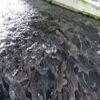The Norwegian Forest Cat is the name given to the forest cat in popular culture i.e. the forest cat is usually referred to and known as the Norwegian forest cat. The forest cats are big, devoted cats that make wonderful family pets. You will find out more about this amiable, friendly and kind breed of cat in this article.
Norwegian forest cats are big, loving cats that are popularly referred to as Wegies by breed experts. Wegies, also known as skogkatt in their native Norway, are loved there more than anywhere else in the world.
These sweet cats make wonderful companions and are easily recognized by their enormous size and quiet, sensitive personalities. Norwegian forest cats are devoted and are easygoing pets. The forest cat will make a wonderful family companion if you can give it plenty of affection, careful grooming, and safe surfaces to climb.
Norwegian forest cats have huge, bulky bodies and are active and strong. According to The Cat Fanciers’ Association (CFA), these cats normally weigh between 12 and 16 pounds, with males being larger than females. They also have a long, bushy tail and a thick coat of hair, which gives them the appearance of being even bigger.
Norwegian forest cats are unquestionably larger than average domestic cats, which typically weigh 8 to 12 pounds, according to studies conducted by a director of the Cornell Feline Health Center. They may weigh up to 18 or even 20 pounds.
Their thick, lustrous coats are water-resistant and made to withstand the severe Norwegian winters. forest cats need frequent brushing and maintenance because their undercoat is thick and keeps them warm. In truth, their winter undercoat will molt in the spring. They do lose their coats.
A variety of colors and designs are available for the Norwegian forest cat coat. White, black, blue, red, cream, silver, and golden are the coat colors of this breed. The plain, bicolor, tortoiseshell, calico, and tabby hair patterns on this fluffy cat’s coat are all options. They have eyes that are various colours of green, gold, copper, or a combination of all three.
Norwegian forest cats have a more slender build and are somewhat smaller than Wegies, which are sometimes likened to Maine coons in appearance. In contrast to the Maine coon, which has rounder eyes, Norwegian forest cats also have almond-shaped eyes.
Read Also : Himalayan Cat Breed Description and Complete Care Guide
This breed is often characterized as being kind, tranquil, and gentle. In general, Norwegian forest cats get along well with kids and other animals and may adapt to a variety of households and lifestyles.
Despite their want for attention, they are undemanding and would prefer you approach them. Wegies are a peaceful breed that don’t make a lot of noise, which fits with their laid-back personality.
The Norwegian forest cat has a strong sense of family. They are engaging and affectionate, and they normally accept their environment. This beautiful breed enjoys cuddling and wants to make friends with everyone.
Norwegian forest cat kittens take roughly five years to mature into full adults due to the sluggish maturation of this species. Owners will get to enjoy a lengthier kitten phase of their pet’s life since their maturation is longer than normal. There will be a lot of play as a result of this kittens behavior.
The Health Care of Norwegian Forest Cats

Norwegian forest cats are normally healthy pets with a lifetime of 14 to 16 years. According to breeders. The forest cat poses the following major health risks:
▪ Hip dysplasia is a disorder that affects the hip’s ball and socket joint and, if left untreated, may progress to arthritis.
▪ Patella luxation: When the knee joint slides out of place, the joint becomes floppy and unstable.
▪ Cardiomyopathy: A heart muscle condition in which the heart’s microscopic structure is abnormal. Cardiomyopathy is a kind of heart muscle illness in which the heart’s microscopic structure is abnormal.
▪ A group of skin conditions known as the “eosinophilic granuloma complex” present as red, raised pimples on the skin that are prone to ulceration and crusting. Although it sometimes occurs on the cat’s face, this is often seen on the inner thigh or lower region of the belly.
Reputable breeders keep an eye on the health of their adult cats and are very careful when breeding them. For cats that may be carriers of GSD IV, a genetic test is available. Almost all respectable breeders provide a health guarantee as well. Schedule regular checkups with the vet and heed to their instructions to maintain the health of your forest cat.
Read Also: Hypoallergenic Cat Breeds Description and Complete Care Guide
Grooming and Care Guide of the Norwegian Forest Cat Breed
The Norwegian forest cat’s thick coat has to be thoroughly brushed once a week to prevent mats and tangles. The forest cat loses the majority of its undercoat once a year in the spring in preparation for the summer, when further insulation is not required. During this seasonal shift, shedding might be substantial, so brush more regularly.
Along with brushing, give your Norwegian Forest Cat a bath every few months, maintain short nails, and inspect and clean the ears monthly.
The entire development of Norwegian forest cats occurs around the age of five. Even as adults, they remain animated and fun but do not engage in excessive activity.
Norwegian forest cats like playing with interesting toys and are often game for some playtime on their terms.
Think about putting out a cat tower or tree so they can climb, perch, and scratch. Your cat will especially like having its tree next to a window so it can happily observe squirrels and birds outdoors.
Despite having a sturdy build, Norwegian forest cats should never put on weight. The best method to avoid weight-related health problems, such as diabetes, heart disease, and hip dysplasia, which may be exacerbated by excess weight, is to keep your Norwegian forest cat slender or slim.
At least twice every day, give your Norwegian forest cat measured portions of food. Don’t keep food out all day; cats who are free-fed have a tendency to eat more often than is required, which might result in excessive weight growth. For recommendations on nutritious diet for your Norwegian forest cat, consult your veterinarian or the breeder.
In conclusion, families that like company but don’t want regular physical touch with their cats can consider getting one of these large, gorgeous cats as a pet. Although Norwegian forest cats like being up close and engaging in play or simple observation, they do not want to constantly be lifted up.
These cats need more maintenance because to their thick coats than breeds with shorter hair, and they are more prone to certain illnesses, but the work is well worth it.
Read Also: Nightshade Plants: A Comprehensive Guide





